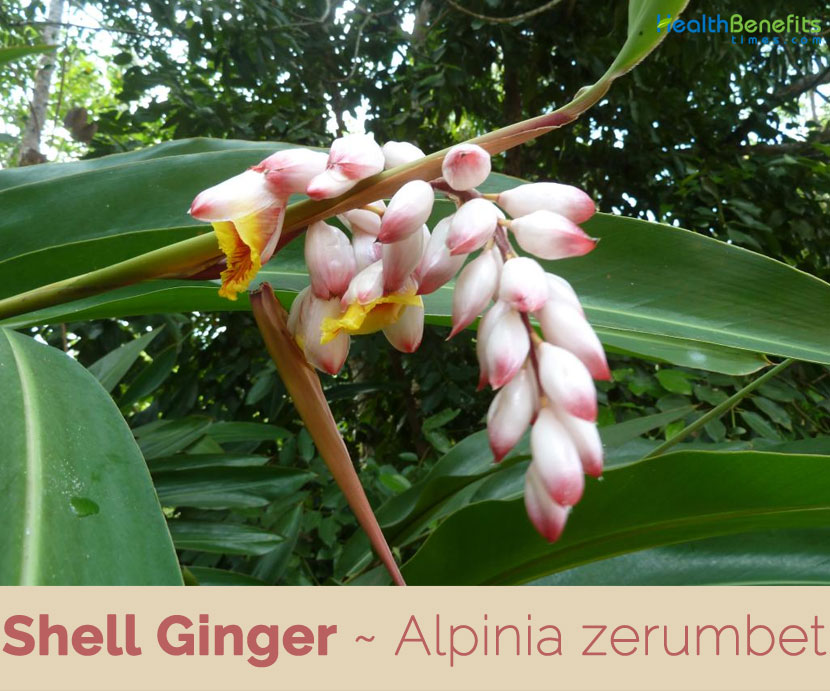| Shell Ginger Quick Facts | |
|---|---|
| Name: | Shell Ginger |
| Scientific Name: | Alpinia zerumbet |
| Origin | Eastern Asia—South Japan to Taiwan and South China to Northern Peninsula, Malaysia |
| Colors | Red |
| Shapes | globose capsules 2.5-3 cm long, and 2 cm in diameter containing about 30 bluish tetragonal seeds |
| Health benefits | Beneficial for depression, stress, anxiety, chronic problems, gastrointestinal and cardiovascular diseases, fever, bloating and indigestion |
Plant Description
Shell Ginger is a robust, rhizomatous, clump forming evergreen, herbaceous perennial plant that grows about 1–3 m tall. The plant more typically reaches 4-8 feet tall in the greenhouse and 3-4 feet tall as a houseplant. The plant is found growing in typically wet environments such as stream banks and shady slopes, and occurs in natural forests, riparian zones, wetlands, watercourses, forest margins, roadsides, urban open space in moist, warm, coastal and inland regions. The plant grows in slightly alkaline to acidic soils on clays, sands or loams. It is moderately drought tolerant but has poor salt tolerance. It is commonly called shell ginger because its individual shell pink flowers, particularly when in bud, look like sea shells and its rhizomes have a ginger-like aroma. It is distinguished from other members of the ginger family by the fact that its flowers sag from the ends of leafy stems rather than rise directly from plant rhizomes.
Leaves
Alternate leaves are simple, broad, and lanceolate to oblong-lanceolate with pointed apex and margins provided of short down. Bright green, shining leaves are up to 30-65 cm long and 5-12 cm broad sheathing the stems and prominent white midrib.
Flower
Flowers are borne in pendant showy and fragrant racemes up to 400 mm long, and its main axis is very hairy; white, waxy and pink tinged ovate bracteoles enfold the buds. Flowers are orchid-like and funnel-formed. Calyx and corolla are tubular, corolla is white, and its labellum is up to 40 mm, crinkled and yellow, with red and brown stripes. Stamens are 3 but only 1 is functional, and it has 2 staminodes. Its ovary is inferior and 3-loculed. Flowering normally takes place from April-June.
Fruit
Fertile flowers are followed by globose capsules 2.5-3 cm long, and 2 cm in diameter, with orange red longitudinal ribs, containing about 30 bluish tetragonal seeds provided of white aril. It reproduces by seed, but usually and easily by division to be done during the winter months.
Traditional uses and benefits of Bright Ginger
- Shell Ginger is used in the northeast and southeast of Brazil as infusions or decoction as a diuretic, anti-hypertensive and anti-ulcer genic.
- In northeastern Brazil, it has been used widely in folk medicine as teas and infusions for the treatment of intestinal and cardiovascular diseases and as hypotonic agent for arterial hypertension and for its anti- inflammatory, bacteriostatic and fungistatic properties
- Shell Ginger is popularly used as a diuretic, anti-hypertensive, anti-ulcerogenic and sedative.
- In phyto-therapy, the essential oil from the leaves of Shell Ginger is used for neuro-psychiatric symptoms, such as depression, stress and anxiety, and chronic problems that are associated with reproductive hormone imbalances in women.
- Shell Ginger has been popularly recognized as an excellent hepato-protector in Chinese folkloric medicine.
- Essential oil from Shell Ginger is widely used in Miao folk herbs in Guizhou province for the treatment of gastrointestinal and cardiovascular diseases
- Plant has been used as a medicine against venoms of snakes and spiders in India.
- Juice from boiled rhizomes, leaves, flowers and seeds is used to treat fever, stomach ache, bloating, indigestion and diarrhea in Vietnam.
- Decoction of the leaves is used as a bath against fevers in Philippines.
- Rhizome stimulates digestion, and is also employed in the treatment of dyspepsia, flatulence, vomiting, gastralgia, colic, diarrhea and malaria.
- Plant is used to treat stomach disorders, vomiting and dyspepsia in China.
- Its rhizome is traditionally applied as a stomachic, carminative, astringent, tonic and sedative.
- Tea made from the leaves is often used as a hypertensive and diuretic medication, particularly in Japan and Brazil.
- In Manipur, fresh rhizome is applied to ringworm and other skin diseases.
- Shell Ginger rhizome is used as spice like Alpinia galanga.
- It has a high value all over the world as a spice in culinary preparations and for its medicinal properties
- Pith of the young stem near the rhizome is commonly eaten in some parts of Malaysia.
- Aromatic leaves are used to wrap rice or fish for cooking in Ambon, Indonesia.
- The plant’s long leaf blades are still used for wrapping zongzi.
- Shell Ginger is known in the local dialect as sannin or in Japanese as ‘getto’ in Okinawa, Japan.
- Its leaves are sold as herbal tea and are also used to flavor noodles and wrap mochi rice cakes.
- Gettou soba is soba which has getto, which is well liked by Okinawans, kneaded into it.
- Shell Ginger is used as food preservative in Okinawa.
- Aromatic leaves are used to wrap rice or fish for cooking, particularly in Okinawa, Japan.
- Tips of the young shoots, leaves and flowers are eaten boiled in parts of Asia.
Other Facts
- It is a popular ornamental plant in home gardens and public areas.
- There is an ornamental cultivar with variegated leaves.
- Plant has been used as source of fiber and the digested pulp has been used for making paper.
- Both flowers and rhizomes are grown for their essential oils and as spice crops.
- Fibers of the shoots and sometimes the whole plant are used for paper production and as a substitute for flax in times of scarcity.
References:
https://www.itis.gov/servlet/SingleRpt/SingleRpt?search_topic=TSN&search_value=182557#null
https://davesgarden.com/guides/pf/go/2333/
https://npgsweb.ars-grin.gov/gringlobal/taxonomydetail.aspx?id=101036
https://www.cabi.org/isc/datasheet/109799
https://plants.usda.gov/core/profile?symbol=ALZE
https://en.wikipedia.org/wiki/Alpinia_zerumbet
https://www.wikiwand.com/en/Alpinia_zerumbet
http://www.theplantlist.org/tpl1.1/record/kew-219119
https://indiabiodiversity.org/species/show/228708
https://uses.plantnet-project.org/en/Alpinia_zerumbet_(PROSEA)
http://www.iucngisd.org/gisd/species.php?sc=1617
http://flora-peninsula-indica.ces.iisc.ac.in/herbsheet.php?id=9642&cat=7
https://gd.eppo.int/taxon/AIIZE
http://tropical.theferns.info/viewtropical.php?id=Alpinia%20zerumbet
http://www.stuartxchange.com/LangkawasNaPula.html
http://www.flowersofindia.net/catalog/slides/Shell%20Ginger.html
Comments
comments
